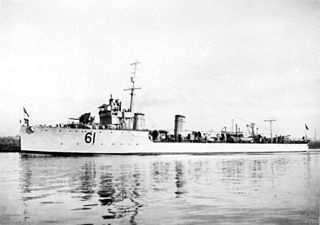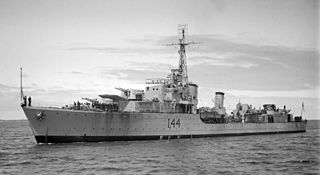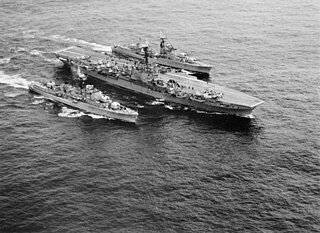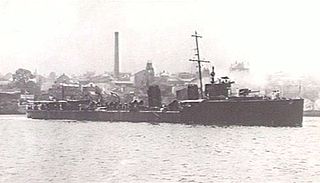
HMAS Parramatta, named for the Parramatta River, was a River-class destroyer escort of the Royal Australian Navy (RAN).

HMAS Stuart was a British Scott-class flotilla leader. The ship was built by Hawthorn Leslie and Company for the Royal Navy during World War I, and entered service at the end of 1918. The majority of the destroyer's British service was performed in the Mediterranean, and in 1933 she was transferred to the Royal Australian Navy. Although placed in reserve in 1938, Stuart was reactivated at the start of World War II to lead the Australian destroyer force, nicknamed the "Scrap Iron Flotilla" by German propagandists.

HMAS Swan was a River-class torpedo-boat destroyer of the Royal Australian Navy (RAN). One of six built for the RAN, Swan was built at Cockatoo Island Dockyard, and entered service in 1916. The early part of the ship's career was spent on blockade duty in the Far East, before she was transferred to the Mediterranean for anti-submarine duty. Apart from performing shore bombardment during the Second Battle of Durazzo, Swan's wartime career was uneventful. The destroyer was placed in reserve in 1920, but was reactivated between 1925 and 1927 and assigned to Tasmania. Swan was decommissioned in 1928, stripped of parts, and sold for use as prisoner accommodation on the Hawkesbury River. After changing hands several times, the hull sank during gale conditions in 1934.

HMAS Sydney was a Chatham-class light cruiser of the Royal Australian Navy (RAN). Laid down in 1911 and launched in 1912, the cruiser was commissioned into the RAN in 1913.

HMAS Sydney (R17/A214/P214/L134) was a Majestic-class light aircraft carrier operated by the Royal Australian Navy (RAN). She was built for the Royal Navy and was launched as HMS Terrible (93) in 1944, but was not completed before the end of World War II. The carrier was sold to Australia in 1947, completed, and commissioned into the RAN as Sydney in 1948.

HMAS Australia was one of three Indefatigable-class battlecruisers built for the defence of the British Empire. Ordered by the Australian government in 1909, she was launched in 1911, and commissioned as flagship of the fledgling Royal Australian Navy (RAN) in 1913. Australia was the only capital ship ever to serve in the RAN.

HMAS Warramunga (I44/D123) was a Tribal-class destroyer of the Royal Australian Navy (RAN). Built during World War II, the destroyer entered service in late 1942. She was initially assigned to convoy escort duties, but was assigned to the joint Australian-American Task Force 74 in 1943, and was involved in supporting numerous amphibious landings through the South-east Asian region until the end of the war. From 1950 and 1952, Warramunga fought in the Korean War, then was converted into an anti-submarine destroyer. Returning to service in 1954, the destroyer was one of the first RAN ships to operate with the Far East Strategic Reserve, and undertook two tours with the organisation before she was decommissioned in 1959 and sold for ship breaking in 1963.

HMAS Norman (G49/D16) was an N-class destroyer operated by the Royal Australian Navy (RAN) during World War II. Entering service in 1941, the ship was on loan from the Royal Navy.

HMAS Vampire was the third of three Australian-built Daring-class destroyers serving in the Royal Australian Navy (RAN). One of the first all-welded ships built in Australia, she was constructed at Cockatoo Island Dockyard between 1952 and 1959, and was commissioned into the RAN a day after completion.

HMAS Vendetta was one of three Daring-class destroyers built for and operated by the Royal Australian Navy (RAN). The destroyer was built by Williamstown Naval Dockyard and entered service in 1958. During her early career, Vendetta was deployed to the Far East Strategic Reserve on multiple occasions. In 1965 and 1966, the destroyer undertook deterrence patrols during the Indonesia-Malaysia Confrontation. Along with several runs escorting the troop transport HMAS Sydney to South Vietnam, from late 1969 to early 1970 Vendetta was assigned to combat operations and became the only Australian-built warship to serve in a shore bombardment role during the Vietnam War.

HMAS Vendetta (D69/I69) was a V-class destroyer that served in the Royal Navy and the Royal Australian Navy (RAN). One of 25 V class ships ordered for the Royal Navy during World War I, Vendetta entered service in 1917.

HMAS Yarra, named for the Yarra River, was a River-class torpedo-boat destroyer of the Royal Australian Navy (RAN). Ordered in 1909 for the Commonwealth Naval Forces, Yarra was temporarily commissioned into the Royal Navy on completion in 1910 and handed over to Australian control on arrival in Australia.

HMAS Torrens, named for the River Torrens, was a River-class torpedo-boat destroyer of the Royal Australian Navy (RAN). The destroyer was built at Cockatoo Island Dockyard and entered service with the RAN in 1916. The destroyer was first deployed to East Asia, then the Mediterranean, where she remained for the rest of World War I. After returning to Australia, the destroyer was decommissioned, but saw use in several ports for reservist training before the decision to sell her for scrap was made. After being stripped, the destroyer was towed outside Sydney Heads, used for gunnery practice, and scuttled.

The River class was a class of six torpedo-boat destroyers operated by the Royal Australian Navy (RAN). The design was based on a modified version of the British River-class destroyer, 13 of which were planned under the 1904 Naval Estimates, but were cancelled before orders were placed. The first batch of three ships was ordered for the Commonwealth Naval Forces in 1909, followed later by a second batch of three a few years later. All six vessels are named after Australian rivers.

HMAS Huon (D50), named after the Huon River, was a River-class torpedo-boat destroyer of the Royal Australian Navy (RAN). Originally to be named after the River Derwent, the ship was renamed before her 1914 launch because of a naming conflict with a Royal Navy vessel.

HMAS Warrego, named for the Warrego River, was a River-class torpedo-boat destroyer of the Royal Australian Navy (RAN). Ordered in 1909, construction of the destroyer started in England, but she was then broken down and reassembled at Cockatoo Island Dockyard in order for the Australian shipbuilding industry to gain experience in warship construction. Warrego was commissioned into the RAN in 1912, and spent her early career operating in Australian waters.

HMAS Waterhen (D22/I22) was a W-class destroyer that served in the Royal Navy and the Royal Australian Navy (RAN). Built during World War I, the destroyer was completed in mid 1918, and commissioned into the Royal Navy. In 1933, Waterhen and four other British ships were transferred to the RAN. The ship's early RAN career was uneventful, with periods spent decommissioned in reserve, but she was reactivated in September 1939, and deployed to the Mediterranean as part of the Australian destroyer force: the Scrap Iron Flotilla. During her time in the Mediterranean, Waterhen was involved in escort and patrol duties, performed shore bombardments, and participated in Allied evacuations from Greece and Crete. On 29 June 1941, while operating with the Tobruk Ferry Service, Waterhen was heavily damaged by two Italian Regia Aeronautica's aircraft, dive bombers Ju 87 Stuka of 239 squadriglia, flown by pilots Serg.mag. Ennio Tarantola e Serg. Lastrucci. Attempts to tow the ship to port were unsuccessful, and she sank on 30 June 1941, the first RAN ship lost to combat in World War II.

The history of the Royal Australian Navy traces the development of the Royal Australian Navy (RAN) from the colonisation of Australia by the British in 1788. Until 1859, vessels of the Royal Navy made frequent trips to the new colonies. In 1859, the Australia Squadron was formed as a separate squadron and remained in Australia until 1913. Until Federation, five of the six Australian colonies operated their own colonial naval force, which formed on 1 March 1901 the Australian Navy's (AN) Commonwealth Naval Force which received Royal patronage in July 1911 and was from that time referred to as Royal Australian Navy (RAN). On 4 October 1913 the new replacement fleet for the foundation fleet of 1901 steamed through Sydney Heads for the first time.

HMAS Yarra (U77), named for the Yarra River, was a Grimsby-class sloop of the Royal Australian Navy (RAN) that served during World War II. Commissioned in 1936, Yarra spent the early part of the war in Australian waters, then was transferred to the East Indies Station in 1940. The sloop operated in the Red Sea, then was involved in the Anglo-Iraqi War and the Anglo-Soviet invasion of Iran. After operating as part of the Tobruk Ferry Service in the Mediterranean during November, Yarra was reassigned to Southeast Asia in response to Japanese attacks. On 4 March 1942, Yarra was attacked and sunk by a force of Japanese cruisers and destroyers while attempting to protect ships withdrawing to Australia.

HMAS Parramatta Shipwreck and Memorials is a heritage-listed shipwreck at Cascade Gully, Hawkesbury River, Bar Point, Central Coast, New South Wales, Australia. The heritage listing also includes three related memorials, two at Queens Wharf Reserve in Parramatta and one at Garden Island in Sydney. The original HMAS Parramatta was commissioned in 1910, paid off in 1928, and wrecked in 1934. The bow and stern sections were subsequently converted into memorials, while the third memorial relates to the second HMAS Parramatta, sunk in service at Tobruk in World War II. It was added to the New South Wales State Heritage Register on 15 December 2006.






















